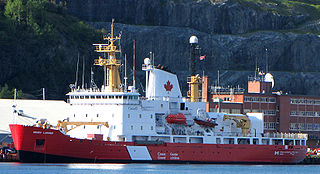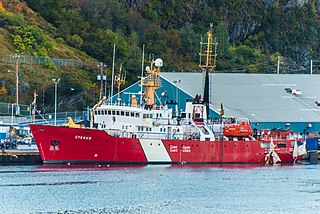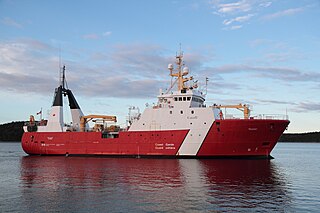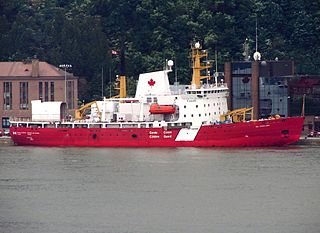
CCGS Henry Larsen is a Canadian Coast Guard Improved Pierre Radisson-class icebreaker serving in the Newfoundland and Labrador region and based in St John's, Newfoundland and Labrador. Entering service in 1988, Henry Larsen is the fourth ship and of an improved design over the rest of the ships in her class. The ship operates in the Arctic Ocean during summer months.

CCGS Samuel Risley is a Canadian Coast Guard icebreaker and buoy tender assigned to the Great Lakes area. Lead ship of her class, the vessel is named after Samuel Risley, the 19th century maritime inspector and first head of Board of Steamship Inspectors for Upper Canada and Ontario. Based in the Great Lakes, CCGS Samuel Risley is responsible for keeping an ice-free passage between Port Colborne, Ontario and Thunder Bay, Ontario.
CCGS Cape Roger is the lead ship of the Cape Roger-class fisheries patrol vessels operated by the Canadian Coast Guard. The ship entered service in 1977 and was assigned to monitor the Atlantic fisheries. During the Turbot War, Cape Roger took part in the detainment of the Spanish fishing trawler Estai. The ship is currently in service.

CCGS Amundsen is a Pierre Radisson-class icebreaker and Arctic research vessel operated by the Canadian Coast Guard. The vessel entered service in 1979 as Franklin and was renamed Sir John Franklin in 1980 and served as such until 1996. Declared surplus, the vessel was used as an accommodation ship in Labrador in 1996 and placed in reserve in 2000. In 2003, the ship was reactivated and underwent conversion to an Arctic research vessel. The ship recommissioned as Amundsen.

CCGS Bartlett is a Provo Wallis-class buoy tender in operation by the Canadian Coast Guard. The vessel entered service in 1969 and was modernized in 1988. In 1982, the ship commanded the recovery efforts following the Ocean Ranger sinking off the coast of Newfoundland. The vessel is assigned to the Pacific Region and is based at Victoria, British Columbia.

CCGS Sir Wilfred Grenfell is a Canadian Coast Guard vessel based in Victoria, British Columbia. Designated an "Offshore Ice Strengthened Multi Patrol Vessel", the former offshore supply vessel is named after the medical missionary in Labrador, Sir Wilfred Grenfell. Constructed in 1984–1985, Sir Wilfred Grenfell was purchased by the Canadian Government and converted for Coast Guard service. In 1994, she played an important role in the fishing conflict known as the Turbot War in the Atlantic Ocean.

CCGS Leonard J. Cowley is an ice-strengthened fisheries patrol vessel of the Canadian Coast Guard. The ship entered service in 1984 and is still currently in service. During the Turbot War, the patrol vessel took part in the detainment of the Spanish fishing vessel Estai. Leonard J. Cowley's home port is St. John's, Newfoundland and Labrador.

CCGS Cygnus is a Cape Roger-class fisheries patrol vessel of the Canadian Coast Guard. The ship entered service in 1981 and is used to monitor the fisheries along the Atlantic coast of Canada. During the Turbot War, Cygnus was among the Coast Guard vessels sent to monitor the European fishing fleet on the Grand Banks.

CCGS John P. Tully is an offshore oceanographic science vessel in the Canadian Coast Guard operating out of Pacific Region at CGS Base Patricia Bay in Sidney, British Columbia. Prior to 1995, the ship was assigned to Fisheries and Oceans Canada. The vessel entered service in June 1985 with the Department of Fisheries and Oceans on the West Coast of Canada. In 1995, the fleets of Fisheries and Oceans and the Canadian Coast Guard were merged under Canadian Coast Guard command and John P. Tully became a Coast Guard vessel.

CCGS Alfred Needler is an offshore fishery science vessel operated by the Canadian Coast Guard. The vessel entered service in 1982 with the Department of Fisheries and Oceans, stationed at the Bedford Institute of Oceanography in Dartmouth, Nova Scotia. In 1995, in order to reduce the number of ships and combine tasks, the Fisheries and Oceans fleet and the Canadian Coast Guard fleets were merged under the Canadian Coast Guard.

CCGS W.E. Ricker was a Canadian Coast Guard offshore fisheries research vessel. The ship was originally constructed as the commercial fishing trawler Callistratus, but was purchased by the Government of Canada in 1984 and converted to a fisheries research vessel and renamed W.E. Ricker. The vessel entered service with the Department of Fisheries and Oceans in 1986 and was transferred to the Canadian Coast Guard in 1995 after the two fleets were amalgamated. The ship was assigned to the West Coast of Canada and was decommissioned on 14 March 2017.

CCGS N.B. McLean was a Canadian Coast Guard icebreaker. Constructed in 1930 at Halifax Shipyards, she entered service as CGS N.B. MacLean and served in the Department of Transport's Marine Service, using the prefix "Canadian Government Ship". The ship was transferred into the newly created Canadian Coast Guard in 1962. She served in the St. Lawrence River and Gulf of St. Lawrence until she was decommissioned in 1979, and taken to Taiwan to be scrapped in 1989. She was replaced by CCGS Pierre Radisson.

CCGS Simcoe was a Canadian Coast Guard buoy tender and light icebreaker. The second vessel of the name in Canadian government service, Simcoe was in service from 1962 to 2007 based out of the Coast Guard base at Prescott, Ontario working the Great Lakes and Saint Lawrence Seaway. In 2008 the ship was sold to commercial interests.

CCGS Gordon Reid is an offshore fisheries patrol vessel of the Canadian Coast Guard. The vessel entered service in 1990 on the West Coast of Canada and is still in active service. In 2014, Gordon Reid responded to the distress signal of MV Simushur which had lost engine power off the coast of Haida Gwaii in British Columbia.

CCGS Teleost is a Canadian Coast Guard fisheries research vessel. The ship was originally constructed in Norway in 1988 as a commercial fishing trawler named Atlantic Champion. In 1993, the Canadian government purchased the vessel and after a competition among schoolchildren, the vessel was named Teleost by the winner. The vessel was converted to an offshore fisheries research vessel in 1994–1995 and entered service in 1996 with the Canadian Coast Guard. The ship is currently in active service.

CCGS Vector is a hydrographic survey vessel in the Canadian Coast Guard. The ship was constructed in Canada and entered service in 1967 as a coastal research vessel on the West Coast. The ship is currently in service, based at Canadian Coast Guard Base Patricia Bay in Sidney, British Columbia.
CCGS Simon Fraser was a buoy tender operated by the Canadian Coast Guard. The vessel entered service in 1960 with the Department of Transport's Marine Fleet, before being transferred to the newly formed Canadian Coast Guard in 1962. The buoy tender served on both coasts of Canada and was used for search and rescue duties along the West Coast of Canada. The ship was loaned to the Royal Canadian Mounted Police in 2000 and transited the Northwest Passage, circumnavigating North America in the process. The ship was taken out of service in 2001 and sold to private interests. In 2006, the vessel reappeared as a yacht using the same name.
CCGS Provo Wallis is a Provo Wallis-class buoy tender that served with the Canadian Coast Guard. The vessel entered service in 1969 and was classed as a Medium-endurance Multi-tasked Vessel. Provo Wallis spent the majority of her career on the Atlantic Coast of Canada before transferring to the West Coast. Ice-strengthened, the ship was used mainly for maintaining navaids in shipping lanes. The vessel was taken out of service in 2011 and laid up.
CCGS J.E. Bernier was a Canadian Coast Guard medium Arctic icebreaker with a steel hull. The vessel was in service from 1967 to 2006. The ship was initially based at Quebec City but finished her career at St. John's. The ship was named for Joseph-Elzéar Bernier, captain of CGS Arctic which explored and monitored the eastern Arctic for the Government of Canada in the early 20th century. The vessel was sold in 2006 to private interests.

The Pierre Radisson-class icebreakers, also known as R-class icebreakers, are a class of four icebreakers constructed for and operated by the Canadian Coast Guard. The Canadian Coast Guard designates the four ships in the class as medium icebreakers. Built in two phases, the first three ships, Pierre Radisson, Franklin and Des Groseilliers, were built to a common design. The fourth, Henry Larsen was built to a modified design and is considered a subclass, the Improved R-class icebreaker. Franklin was later renamed Sir John Franklin before undergoing a re-design for use primarily as an Arctic research vessel. Upon the vessel's return to service, the ship was once again renamed Amundsen. All the vessels are named for people who sailed through Canada's northern waters. The class operates in the Arctic Ocean in the summer, patrolling, icebreaking and research missions.















